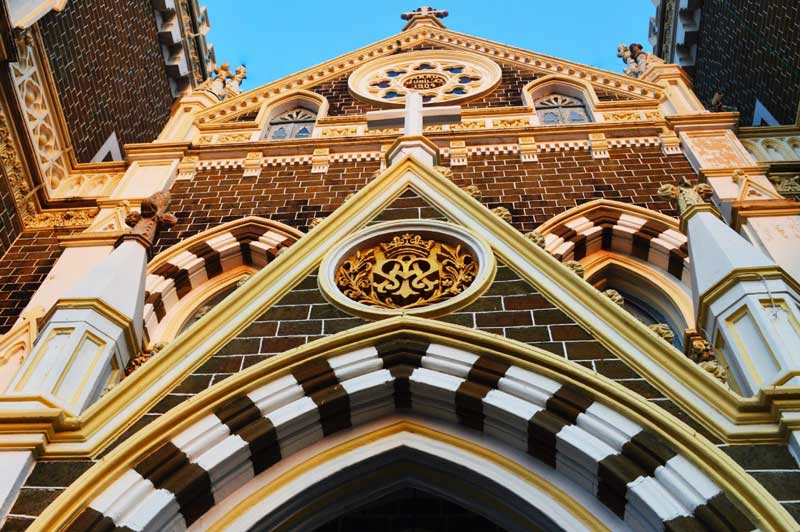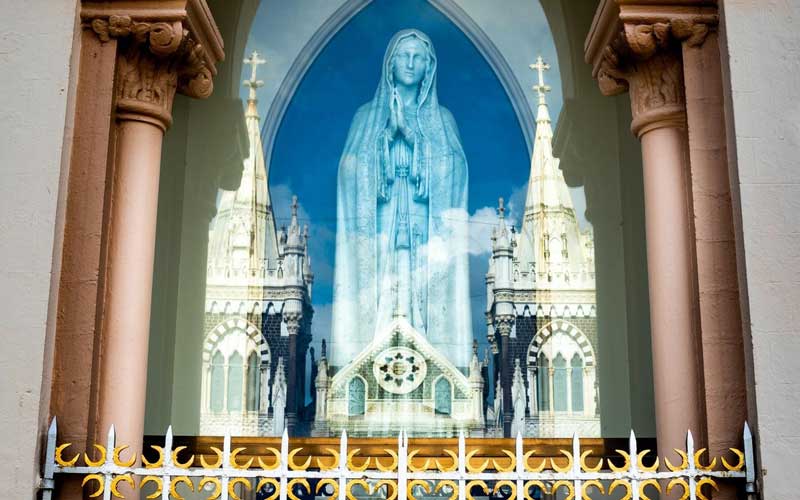
Standing tall for centuries on a hillock 262 feet (80 m) above sea level overlooking the Arabian Sea, The Basilica of Our Lady of the Mount, commonly called the Mount Mary Church, a Roman Catholic Basilica located in Bandra area in Bombay, renamed Mumbai in 1995, is visited by people of all faiths for peace and tranquillity. The local Marathi Christians call it Maulicha Dongar in the Marathi language, which stands for Hill of the Mother and the shrine of the Virgin Mary holding Baby Jesus is called Moti Mauli or Pearl Mother.
They pray to Mother Mary by offering her a wax figurine, available in the adjacentsmall shops that sell flowers, candles and other offerings of worship. Following Pope Francis’s declaration 2016, the main door of Mount Mary Church has also been declared as Holy Doors of Mercy, along with the main door of Holy Name Church, located in the Colaba area, in the city. Since then, these doors have become pilgrimage sites for Catholics to walk through, asking for grace, purification and forgiveness from sins.

The history of the Mount Mary Church, one of the oldest churches in Bombay, dates back to the sixteenth century when around 1570, a Jesuit Priest constructed an oratory devoted to the Virgin Mary, out of mud on a hillock in Bandra. Later, the statue of Mother God was placed on the altar of the oratory, which was made of wood and shipped from Portugal by the Jesuit Priests. The oratory was transformed into a chapel in 1640, which was raided by the Marathas in 1738, who ransacked the chapel while looking for any hidden treasure.
When they found nothing, they chopped off the right forearm of Mary's statue in desperation, thinking it was made of gold. It is said that, while they destroyed the chapel, their intention to burn it down was not fulfilled, as a huge swarm of bees entered the church and attacked them mercilessly.

However, the destroyed church was rebuilt in 1760 and the disfigured statue of Mother Mary was substituted with a statue of Our Lady of Navigators, brought in from the side altar of St. Andrew’s Church nearby. Nevertheless, there is an alternative version about the replacement of the statue. According to a local legendary tale, once a Koli fisherman dreamt that he would find the statue of Mother in the sea and to his utter surprise, on the next day in the morning, he found the statue floating in the sea. Strangely, a Jesuit Annual Letter that dated back to 1669 and published in the book St. Andrew's Church, Bandra, also supported the claim and mentioned that the statue had been floating in the sea between 1700 and 1760. Whatever it may be, the old broken statue of Our Lady of the Mount was enshrined in a place of honour in the basilica, after fixing it by moulding in a detachable statue of a child Jesus in the place of its broken hand.

The beautiful semi-gothic structure of the Mount Mary Church with its 98 feet tall pyramidal spires, each mounted with a cross, with foundations totalling around 18 feet, including the length and breadth, is a stunning example of excellent craftsmanship. The façade of the impressive four storey structure, around 65 feet in width, with foundations deep-rooted inside the rocks and supported by strong buttresses, reflects much about its magnificent architecture.
The main entrance of the basilica is equipped with a huge door, along with beautiful windows on either side, crowned with gothic stone arches to protect the wooden panels from rain. The arch over the main portal bears the letters A and M, representing the emblem of the basilica, the initial letters of the Latin greeting, Ave Maria, the famous greeting of Angel Gabriel to Mother Mary. The letters are mounted on a crown and surrounded by two lilies on either side.

The inner walls of the basilica are aesthetically adorned with beautiful fibreglass murals, depicting stories from the life of Mary. While the tranquil central nave is made out of stone slabs measuring 67 feet in length and 38 feet broad, the 42 feet high ceiling is made of teakwood, protected by a roof made of Mangalore tiles. There is a four feet high marble pulpit towards the high altar, engraved with liturgical symbols on the outer side of the pulpit, together with two tablets, reproducing the 10 commandments carved on them. The sanctum Sanctorum is comprised of a white marble seven step high altar, decorated with the legendary statue of the Virgin Mary holding child Jesus on its top. There is a marble plaque embedded at the lower level of the high altar with a carving representation of the Last Supper, the final meal that, according to the gospel, Jesus shared with his twelve apostles in Jerusalem, before his crucifixion.

The famous feast of Our Lady of the Mount, organised by the church committee in Bandra and known as the Bandra Fair, is celebrated on 8th September, when the entire area is decorated with festoons and buntings and devotees throng to the basilica to pay homage to the great mother. During the 8-day long carnival, small stalls are arranged inside the church complex for selling snacks and sweets, religious articles and candles of different sizes and shapes, along with wax figurines of the Virgin Mary. Even, different rides and concerts are also held to complete the festive mood.